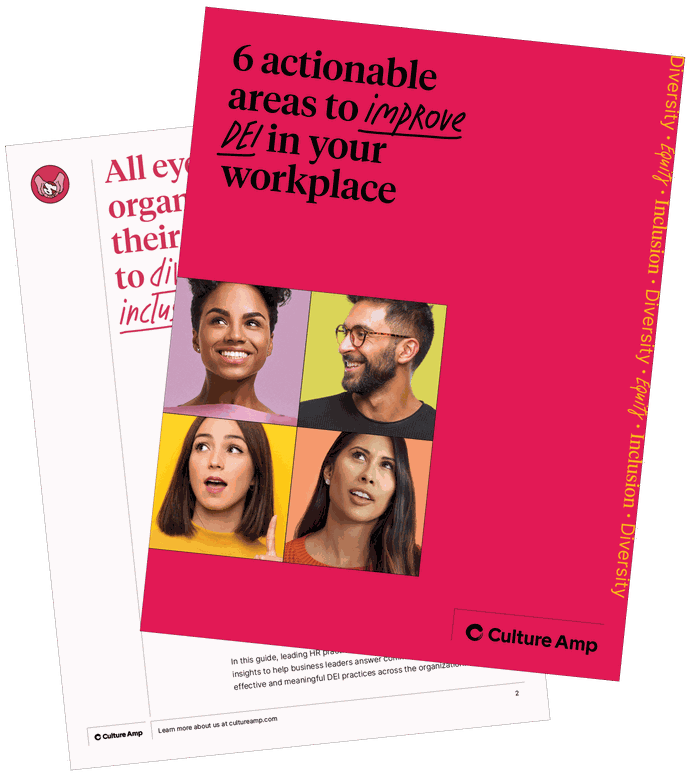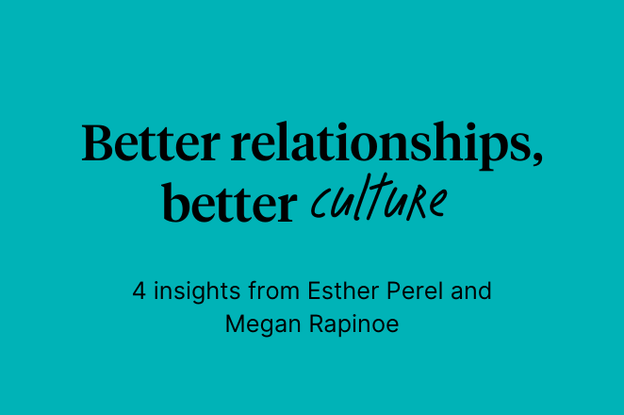13 opportunities to address workplace bias

Marketing Lead, Bonusly
You want to believe that you’re inclusive and open-minded. That you celebrate people’s differences. That you’re respectful of alternative beliefs and ideas. That you’re accepting of everybody’s backgrounds and experiences.
Being well-intentioned is one thing. But when it comes to being inclusive, there’s something that can hold you back without you even realizing it: your unconscious bias.
What is unconscious bias in the workplace?
Let’s start with a definition of unconscious bias (also known as “implicit bias”). According to UCSF’s Office of Diversity and Outreach, these biases “are social stereotypes about certain groups of people that individuals form outside their own conscious awareness.” Think of unconscious biases as stereotypes you’ve accidentally internalized – automatic preferences that influence your opinions and your actions.
Workplace bias occurs when your unconscious bias directly impacts your decisions and interactions at work, whether it’s showing a preference for younger candidates when hiring or assuming that the man in the meeting room is the leader.
The tricky thing about unconscious bias is that it happens, well, unconsciously – and these biases can even contradict viewpoints that you believe yourself to hold.
What are the different types of unconscious bias?
Workplace unconscious bias is the broader term, but there are many different types of biases that fall under this category, including:
- Affinity bias: Preferring people who are similar to yourself in background, interests, or experiences.
- Age bias: Judging people based on stereotypes related to their age.
- Confirmation bias: Seeking out information that confirms your existing beliefs about a person.
- Gender bias: Favoring one gender over another.
- Maternal bias: Assuming that a working mother is less committed or capable because of her family responsibilities.
- Name bias: Making assumptions about someone’s abilities or character based on their name.
- Physical appearance bias: Treating people differently based on their physical attributes and overall appearance.
- Reactance bias: our unconscious tendency to react to rules and regulations by exercising our freedom.
While it’s not an exhaustive list, it details some of the most common ways implicit bias in the workplace can sneak its way into your decision-making and thought processes.
How does unconscious bias affect the workplace?
It’s a tough pill to swallow, but workplace bias is alarmingly common – affecting 90 to 95% of people, according to some estimates. And unfortunately, the impacts of this implicit prejudice extends far beyond simply misjudging someone.
For starters, it can limit diversity within your organization. When biases creep into hiring decisions, people are more likely to build homogenous teams. In turn, that can limit innovation and worsen decision-making.
Additionally, unconscious biases can reduce equitable opportunities for your existing employees. When they’re unfairly and inaccurately judged, they can miss out on chances for promotions and other development opportunities that they’re deserving of.
That unfair and exclusive treatment can erode the overall company culture and the employee experience over time, especially when unconscious biases also manifest as microaggressions at work.
Because unconscious biases have the greatest influence over us when we’re stressed or under time constraints – two types of pressure we often face at work – it takes an active effort to recognize when our biases are at play and mitigate the impact they have on your coworkers and customers.
How to reduce bias in the workplace: 13 areas to watch
Because unconscious biases have the greatest influence over us when we’re stressed or under time constraints – two types of pressure we often face at work – it takes an active effort to recognize when our biases are at play and mitigate the impact they have on your coworkers and customers.
Wondering how to reduce stereotyping in the workplace? We've identified 13 areas where biases may negatively impact your workplace DEI efforts. Once you've determined where your biases are lurking, you can start challenging the status quo, unlearning the harmful stereotypes you've accidentally internalized, and counteracting unconscious bias.
1. Job postings
With highly transparent employer review and recruiting sites like Glassdoor and AngelList, prospective employees aren’t the only audience reading your job postings. As a form of external, public-facing communication, job descriptions should be written in your brand voice and optimized to appeal to the broadest pool of candidates.
Textio’s Tim Halloran speaks to the underlying bias in the workplace that often informs word choice:
“Gendered language isn’t always obvious or intuitive...There are plenty of seemingly random examples like ‘exhaustive,’ ‘enforcement,’ and ‘fearless’ that are statistically proven to skew your talent pool (toward men in this case), and it’s highly unlikely you’re going to hear about those at your company’s unconscious bias training workshop.”
Takeaway
Audit the language in your job listings and revise if necessary to appeal to a more diverse, qualified pool of applicants. Strive toward gender-neutral language that doesn't play into stereotypes of masculinity or femininity. Additionally, keep an eye out for words or duties that could automatically rule out candidates with disabilities.
2. Company policies
Dr. Travis Bradberry, the author of Emotional Intelligence 2.0, writes in Entrepreneur: “Employees who feel mistreated or ‘Big Brothered’ by their employers are more likely to take longer breaks, extra sick days, or even steal from their company.” When leaders design policies to limit unwanted behaviors instead of focusing on desired behaviors, they are sending a tacit message of distrust.
“Policies are a company’s message to its employees regarding how it values people,” writes workplace consultant Sue Bingham. “Can you reframe punitive rules as positive goals to aim for?”
For that reason, it's crucial to consider what might be making it hard for your employees to bring their whole selves to work.
Corporate dress codes have been challenged for prescribing appearances without valid business reasons. If employees feel restrained by your dress code for reasons determined by their finances, religious beliefs, gender identities, or any other cause, you are causing them more stress than you are alleviating.
Restrictive sick leave and time-off policies can be biased against individuals living with acute illness or mental illness, persons who are family planning, and employees who wish to protect their medical privacy. These policies can discourage your employees from taking care of themselves. With the unlimited vacation policies so popular in startups, you’d think more people would be taking breaks – but they’re not.
Takeaway
Prioritize your employees’ diverse range of personal comfort when revising company policies. Remember to take a look at your processes for things like employee evaluations as well to confirm that performance review bias isn’t becoming a problem.
3. Benefits
The perks and benefits your company offers can attract potential employees and help retain current employees. Alternatively, subpar benefits can deter prospective employees from applying or make them want to leave.
Companies ensure that their employees bring their best, strongest, healthiest selves to work by providing benefits like health insurance. However, unconscious biases can prevent us from empathizing with others and understanding their unique needs, so when decision-makers create benefits programs in a vacuum, without the input of their intended users, they’re bound to have weaknesses.
In recent years, a shift towards more inclusive parental leave policies has reflected changing dynamics in gender roles. Imagine your employee, Henry, and his husband are planning to adopt a baby. If your parental leave policy doesn’t accommodate male, female, and gender-nonconforming individuals welcoming someone new into their life, Henry might be hesitant to ask for time off and consider looking for work at a company with more equitable benefits.
Recent research from the Society for Human Resource Management (SHRM) found that 60% of employees rate benefits as a very important contributor to job satisfaction, proving that it’s an area you can’t overlook when it comes to employee happiness and engagement.
Takeaway
Your employees want to feel valued. Speak candidly with them about their health and wellness. Insurance coverage, if your company provides it, might be less equitable than you think, especially when it comes to supporting your LGBTQ+ employees.
4. Marketing and communications
As your company grows and your user personas evolve, are you challenging yourself to change your understanding of their wants and needs, too?
As Valentina Zarya explains in Fortune, “Most Americans tend to be biased in favor of the white, male, heterosexual majority – even when they themselves do not fall into that group, according to findings by Project Implicit, a Harvard University-run nonprofit focused on studying social cognition.”
Questioning the status quo that is the commercial success of past marketing campaigns, Tom Knox, former president of the Institute of Practitioners of Advertising, notably said, “We need to find ways of actively demonstrating that better results, better creativity, better thinking, and better commercial success comes from embracing diversity.”
We need to find ways of actively demonstrating that better results, better creativity, better thinking, and better commercial success comes from embracing diversity.
— Tom KnoxInstitute of Practitioners of AdvertisingTakeaway
Assess the visuals you share with the public on a regular basis and compare them to your audience. Are there discrepancies? Remember that small improvements, like replacing one picture, can have a significant impact.
5. Food and events
Workplace bias can block us from intuiting the needs of the people around us and make us oblivious to what might usually be obvious.
Alternatives to after-work events, like Learn-and-Lunch programs and company outings, are more inclusive of employees who have children, hold second jobs, are going to school, or are otherwise limited to work hours.
If company events always center around alcohol, you could be excluding employees who choose not to drink, whether for their religion, health, or lifestyle.
For catered lunches, make a concerted effort to accommodate your coworkers with dietary restrictions, whether they have food allergies, are vegan, keep kosher, or observe halal. Acknowledging and satisfying unique food requirements is an inclusive move that does not take much discretionary effort.
Takeaway
Making people comfortable at work isn’t a one-size-fits-all initiative. By putting extra thought into food and events, you can show your employees that you care about what makes them unique.
6. Environment
If you don’t know how to start breaking down institutionalized bias, you can start with an essential goal to make sure that everyone can use the bathroom comfortably, no matter their circumstances. Find a way to discuss individual needs for bathrooms with a lot of employees: what one person needs, someone else might find extraneous.
Private and accessible stalls, gender-neutral bathrooms, noise-canceling accommodations, clean and functioning equipment. What might seem like basic dignities are especially important at work, where individuals might feel uncomfortable asking for accommodations.
Anticipating users’ needs is part of good product design, so apply the same approach to how you treat your employees – whether it involves your bathroom, conference rooms, or anything in between.
Takeaway
Encourage your employees and coworkers to assess their work environments. With anonymous input from multiple sources, you’ll be empowered to identify the weaknesses in common assumptions about what people need.
7. Leadership
Antonesia “Toni” Wiley writes in Nonprofit Quarterly that we cannot have conversations without the people we are trying to help. The three questions that help Wiley directly face her unconscious biases are as follows:
- Where are they?
- Why aren’t they here?
- Why are we having conversations without them?
Consider this: if your company’s leadership is made up of primarily heteronormative white males, you have a great opportunity to bring fresh perspectives into your organization. Welcoming diverse leaders who will add to your company culture can have a noticeable effect on employees at all levels.
Takeaway
Look internally. Are you supporting professional development for underrepresented minorities? Culture Amp's VP, Equitable Operations, Aubrey Blanche-Sarellano, reports that peer support makes all the difference.
Also, note that while diversity training can be helpful for improving how leadership handles DEI, it's not a cure-all on its own.
8. Location
If you expect employees to be on-site (even part of the time), do you pay them competitively so that they can keep up with the cost of living in your area without relying on savings they might not have?
On the flip side, locations listed on a resume can unintentionally influence anyone in a hiring role. Whether applicants are applying from out of state, live just down the road, or are in an up-and-coming part of town, seeing an address on their application materials can impact your impression of their qualifications.
Takeaway
If your location makes it difficult for employees to stay with the company, it’s better to know now. Update your cost of living calculations regularly and consider adopting blind application processes so your biases against applicants won't influence your decisions.
9. Holidays
If your company already recognizes national holidays like Christmas, making accommodations for employees to take time off to celebrate other holidays throughout the year might seem excessive. However, acknowledging that your employees are different from you and might celebrate in different ways will open the door for them to be fully present at work when they are there and take time to rest and celebrate with their loved ones when it’s appropriate for them.
For example, at Dribbble, employees observe both American and Canadian national holidays.
“Because most of our team is equally spread across Canada and the USA, we found that our Slack channels got awfully quiet during Canadian holidays that weren’t also observed in the United States, and vice versa,” writes Chloe Oddleifson. “We didn’t get a whole lot of work done without the majority of the team online, so now we have a ‘CanAmerican’ holiday schedule.”
Takeaway
You don’t have to do what’s always been done. Consider implementing a flexible holiday schedule that reflects the varied geographic and cultural backgrounds of your employees.
10. Products
Diverse points of view make products better. Modupe Akinnawonu, a product manager at The New York Times, puts it simply: “Without diverse perspectives and experiences in designing, building, and testing, products can and will fail female and minority users.”
Akinnawonu continues: “Companies with a culturally diverse leadership team are more likely to develop new products.”
David Thomas, H. Naylor Fitzhugh, Professor of Business Administration at Harvard Business School, says: “The way I look at it is, if our customer base is diverse, we need diversity in our workforce so that we can learn from our own diversity to make ourselves more effective at meeting the needs of our clients.”
Takeaway
When the diversity of your team reflects the diversity of the customers you serve, the better their experience with your product or service will be.
11. Accessibility
Can colleagues, clients, job candidates, or friends with limited mobility comfortably visit your workplace? Or can they easily engage with all of your resources and materials?
Despite the fact that persons with disabilities compose such a significant portion of the population, workplaces aren’t always designed to be accessible. There are a lot of changes, both large and small, that can make a meaningful impact on workplace accessibility.
Takeaway
To learn more about providing spaces – whether in-person, remote, or both – that are inviting and comfortable for all people, take a look at SHRM’s comprehensive toolkit, “Developing an Accessible Workplace” and Culture Amp's Disability in the Workplace blog series.
12. Meetings
Akinnawonu, product manager at The New York Times, observes biases in the structure of a standard meeting.
“Create spaces that guarantee everyone’s voice is heard by remembering that not everyone likes to speak up in meetings,” she suggests. “Set agendas ahead of time so everyone can contribute, create space in group meetings for individual brainstorming, and provide other channels for feedback.”
Asking what other people need and observing what makes them comfortable, especially if it’s different from what makes you comfortable, can help you hold more efficient and productive meetings.
Takeaway
While extroverted employees might be comfortable speaking up in meetings, introverted employees might not. Support everyone’s ability to contribute by providing multiple avenues for communication.
13. Teams
When it comes to confronting workplace bias, you can’t just look at your numbers as a whole – you need to look at individual teams. After all, you might employ plenty of women, but are any of them in engineering? Or are they all in HR and marketing?
Zoom in to analyze your access to opportunities on a team basis to determine whether you’ve actually addressed bias on your teams or you’re glossing over a larger issue.
Takeaway
Make a point of discussing your implicit bias in the workplace with your team. Building trust and encouraging honesty can help departments run more smoothly. When hiring, broaden your scope by looking for candidates who will be culture adds, not just culture fits.
Keeping workplace bias at bay
You might think that inclusivity is second nature but, in reality, your unconscious bias can lead you to misjudge and potentially even mistreat the people you work with. And even worse? You might not even realize it’s happening.
Keep a close eye on the above areas where biases often rear their ugly head and then take steps to remedy them. Being more aware is the first step in banishing your biases at work.
If you want to keep learning about unconscious biases, I recommend watching these two TED talks, which I found to be very helpful while I was writing this piece:
- “How to overcome our biases? Walk boldly towards them” by Verna Myers
- “Color blind or color brave?” by Mellody Hobson

Build a workplace where everyone can thrive
Get 6 actionable areas for improving DEI in your workplace.
This article originally appeared on the Bonusly blog. It has been republished with permission. The blog has been updated and revised on July 15, 2021.





